

Congress Seeks to Establish New Student Data System with College Transparency Act. Policy Congress Seeks to Establish New Student Data System with College Transparency Act A new bipartisan bill introduced this week in the United States Senate and House of Representatives aims to increase transparency on higher education outcomes.
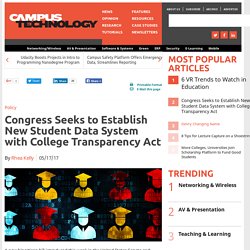
The College Transparency Act of 2017 proposes a student data reporting system that tracks outcomes such as enrollment, completion and post-college success. It would overturn a ban on federal student-level data collection that came about with the 2008 reauthorization of the Higher Education Act. Statements from the Senate and House seem to downplay security and privacy issues in favor of the potential to help students make more informed choices about postsecondary education. "Education is the single best investment a person can make in today's economy. The bill puts security and privacy protection for the postsecondary student data system in the hands of the National Center for Education Statistics (NCES). Measuring What Matters: Defining Outcomes in HE. Critical Thinking Testing and Assessment. The purpose of assessment in instruction is improvement.

The purpose of assessing instruction for critical thinking is improving the teaching of discipline based thinking (historical, biological, sociological, mathematical thinking…). It is to improve students’ abilities to think their way through content, using disciplined skill in reasoning. The more particular we can be about what we want students to learn about critical thinking, the better can we devise instruction with that particular end in view.
RUBRICS: Higher Ed Learning Outcomes Assmt Movement Moves Away from Standardized Tests, According to New National Survey. For Immediate Release Contact: Carrie Johnson Associate Director of Marketing and Media Relations johnson@aacu.org; 202-387-3760, ext. 811 Increasing Focus on Rubrics Applied to Student Work Products and on Student Engagement in Research and Hands-On Projects Washington, DC—February 17, 2016—The Association of American Colleges and Universities (AAC&U) released today the third report from a national survey of Chief Academic Officers (CAOs) conducted by Hart Research Associates.
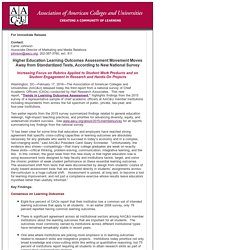
Two earlier reports from the 2015 survey summarized findings related to general education redesign, high-impact teaching practices, and priorities for advancing diversity, equity, and underserved student success. Key Findings: Consensus on Learning Outcomes. Classroom Projects. Is It Time To Dismantle the Lecture Hall? Big Picture | News Is It Time To Dismantle the Lecture Hall?
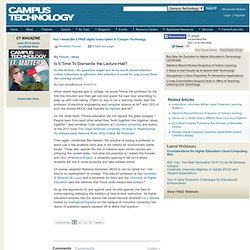
In this debate, the question might not be so much about whether online education is effective, but whether it could be any worse than the existing model. 55% More STEM Students Fail Lectures Than Active Learning Classes. Teaching & Learning | News 55% More STEM Students Fail Lectures Than Active Learning Classes Traditional lectures are failing students in STEM disciplines (science, technology, engineering and math).
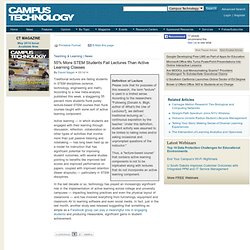
Digital Resources for Net Professionals. Ten Takeaway Tips for Using Authentic Assessment in Your School. The School of the Future's (SOF) mission is to empower each and every student.

Teachers accomplish this not only by making their classroom content and instruction engaging but also by making their assessments authentic. Teachers ask SOF students to demonstrate their comprehension and mastery of the curriculum in ways that are meaningful to them. This goes beyond getting the "right" answers on tests. At SOF, students develop the learning skills and habits of mind that are essential in the classroom -- and the rest of their lives. Here are ten tips to help you use authentic assessment in your school. 1. Authentic assessment can seem overwhelming at first. 2. Authentic assessment can be deeply rewarding for everyone involved, but it does take time and effort and can be demanding on teachers. 3.
SOF teachers design their concluding summative assessments first. 4. 5. You can be creative with authentic assessments, but you still have to base your assessments on the standards you are teaching. Tips for Giving Online Class Feedback and Construcive Criticism. Written by: Sylvia Cochran•edited by: Sarah Malburg•updated: 4/25/2013 Learning how to give online class feedback is more challenging than many a virtual education instructor imagines.
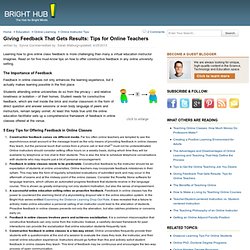
Read on for five must-know tips on how to offer constructive feedback in any online university setting. The Importance of Feedback Feedback in online classes not only enhances the learning experience, but it actually makes learning possible in the first place.Students attending online universities do so from the privacy – and relative loneliness or isolation – of their homes. Chunking Information for Instructional Design.
If we ran a contest for the favorite esoteric word of Instructional Designers, the term “chunking” might win.
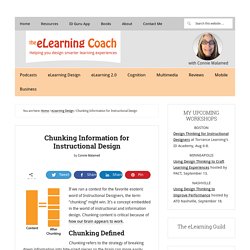
It’s a concept embedded in the world of instructional and information design. Chunking content is critical because of how our brain appears to work. Chunking Defined Chunking refers to the strategy of breaking down information into bite-sized pieces so the brain can more easily digest new information. The reason the brain needs this assistance is because working memory, which is where we manipulate information, holds a limited amount of information at one time.
Why We Chunk Content George A. The pearl of wisdom here is that if a learner’s working memory is full, the excess information will just drop out—as in disappear. Examples of Tasks & Rubrics. How [not] to Design an Online Course. Moving a face-to-face credit course to an online environment is far more challenging than one might expect – as numerous experienced and esteemed professors have discovered.
![How [not] to Design an Online Course](http://cdn.pearltrees.com/s/pic/th/design-learning-insights-36128011)